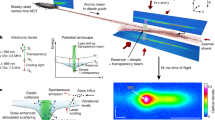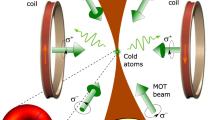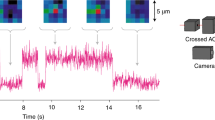Abstract
Although Bose–Einstein condensates1,2,3 of ultracold atoms have been experimentally realizable for several years, their formation and manipulation still impose considerable technical challenges. An all-optical technique4 that enables faster production of Bose–Einstein condensates was recently reported. Here we demonstrate that the formation of a condensate can be greatly simplified using a microscopic magnetic trap on a chip5. We achieve Bose–Einstein condensation inside the single vapour cell of a magneto-optical trap in as little as 700 ms—more than a factor of ten faster than typical experiments, and a factor of three faster than the all-optical technique4. A coherent matter wave is emitted normal to the chip surface when the trapped atoms are released into free fall; alternatively, we couple the condensate into an ‘atomic conveyor belt’6, which is used to transport the condensed cloud non-destructively over a macroscopic distance parallel to the chip surface. The possibility of manipulating laser-like coherent matter waves with such an integrated atom-optical system holds promise for applications in interferometry, holography, microscopy, atom lithography and quantum information processing7.
This is a preview of subscription content, access via your institution
Access options
Subscribe to this journal
Receive 51 print issues and online access
$199.00 per year
only $3.90 per issue
Buy this article
- Purchase on Springer Link
- Instant access to full article PDF
Prices may be subject to local taxes which are calculated during checkout





Similar content being viewed by others
References
Anderson, M. H., Ensher, J. R., Matthews, M. R., Wieman, C. E. & Cornell, E. A. Observation of Bose–Einstein condensation in a dilute atomic vapor. Science 269, 198–201 (1995).
Davis, K. B. et al. Bose–Einstein condensation in a gas of sodium atoms. Phys. Rev. Lett. 75, 3969–1690 (1995).
Bradley, C. C., Sackett, C. A. & Hulet, R. G. Bose–Einstein condensation of lithium: observation of limited condensate number. Phys. Rev. Lett. 78, 985–989 (1997).
Barrett, M. D., Sauer, J. A. & Chapman, M. S. All-optical formation of an atomic Bose–Einstein condensate. Phys. Rev. Lett. 87, 010404-1–010404-4 (2001).
Reichel, J., Hänsel, W. & Hänsch, T. W. Atomic micromanipulation with magnetic surface traps. Phys. Rev. Lett. 83, 3398–3401 (1999).
Hänsel, W., Reichel, J., Hommelhoff, P. & Hänsch, T. W. Magnetic conveyer belt for transporting and merging trapped atom clouds. Phys. Rev. Lett. 86, 608–611 (2001).
Calarco, T. et al. Quantum gates with neutral atoms: Controlling collisional interactions in time-dependent raps. Phys. Rev. A 61, 022304-1–022304-11 (2000).
Weinstein, J. D. & Libbrecht, K. G. Microscopic magnetic traps for neutral atoms. Phys. Rev. A 52, 4004–4009 (1995).
Ott, H., Fortagh, J., Schlotterbeck, G., Grossmann, A. & Zimmermann, C. Bose–Einstein condensation in a surface microtrap. Phys. Rev. Lett. (in the press).
Müller, D., Anderson, D. Z., Grow, R. J., Schwindt, P. D. D. & Cornell, E. A. Guiding neutral atoms around curves with lithographically patterned current-carrying wires. Phys. Rev. Lett. 83, 5194–5197 (1999).
Dekker, N. H. et al. Guiding neutral atoms on a chip. Phys. Rev. Lett. 84, 1124–1127 (2000).
Müller, D. et al. Waveguide atom beamsplitter for laser-cooled neutral atoms. Opt. Lett. 25, 1382–1384 (2000).
Cassettari, D., Hessmo, B., Folman, R., Maier, T. & Schmiedmayer, J. Beam splitter for guided atoms. Phys. Rev. Lett. 85, 5483–5487 (2000).
Reichel, J., Hänsel, W., Hommelhoff, P. & Hänsch, T. W. Applications of integrated magnetic microtraps. Appl. Phys. B 72, 81–89 (2001).
Ketterle, W. & van Druten, N. J. in Advances in Atomic, Molecular and Optical Physics Vol. 37 (eds Bederson, B. & Walther, H.) 181–236 (Academic, San Diego, 1996).
Drndić, M., Johnson, K. S., Thywissen, J. H., Prentiss, M. & Westervelt, R. M. Micro-electromagnets for atom manipulation. Appl. Phys. Lett. 72, 2906–2908 (1998).
Fortagh, J., Ott, H., Grossmann, A. & Zimmermann, C. Miniaturized magnetic guide for neutral atoms. Appl. Phys. B 70, 701–708 (2000).
Anderson, B. P. & Kasevich, M. A. Loading a vapor-cell magneto-optic trap using light-induced atom desorption. Phys. Rev. A 63, 023404-1–023404-4 (2001).
Petrov, D. S., Shlyapnikov, G. V. & Walraven, J. T. M. Phase-fluctuating 3D Bose–Einstein condensates in elongated traps. Phys. Rev. Lett. 87, 050404-1–050404-4 (2001).
Dettmer, S. et al. Observation of phase fluctuations in Bose–Einstein condensates. Phys. Rev. Lett. (in the press); preprint cond-mat/0105525 at 〈http://xxx.lanl.gov〉 (2001).
Henkel, C., Pötting, S. & Wilkens, M. Loss and heating of particles in small and noisy traps. Appl. Phys. B 69, 379–387 (1999).
Cornell, E. A., Ensher, J. R. & Wieman, C. E. in Proc. Int. School of Physics “Enrico Fermi”, Course CXL (eds Inguscio, M., Stringari, S. & Wieman, C.) 15–66 (IOS, Amsterdam, 1999).
Hinds, E. A., Vale, C. J. & Boshier, M. G. Two-wire waveguide and interferometer for cold atoms. Phys. Rev. Lett. 86, 1462–1465 (2001).
Hänsel, W., Reichel, J., Hommelhoff, P. & Hänsch, T. W. Trapped-atom interferometer in a magnetic microtrap. Phys. Rev. A (in the press).
Folman, R. et al. Controlling cold atoms using nanofabricated surfaces: Atom chips. Phys. Rev. Lett. 85, 5483–5487 (2001).
Acknowledgements
This work was supported in part by the European Union under the IST programme (ACQUIRE project).
Author information
Authors and Affiliations
Rights and permissions
About this article
Cite this article
Hänsel, W., Hommelhoff, P., Hänsch, T. et al. Bose–Einstein condensation on a microelectronic chip. Nature 413, 498–501 (2001). https://doi.org/10.1038/35097032
Received:
Accepted:
Issue Date:
DOI: https://doi.org/10.1038/35097032
This article is cited by
-
A space-based quantum gas laboratory at picokelvin energy scales
Nature Communications (2022)
-
Refrigeration Below 1 Kelvin
Journal of Low Temperature Physics (2021)
-
Engineering of microfabricated ion traps and integration of advanced on-chip features
Nature Reviews Physics (2020)
-
Tunable spinful matter wave valve
Scientific Reports (2019)
-
Integrated atomic quantum technologies in demanding environments: development and qualification of miniaturized optical setups and integration technologies for UHV and space operation
CEAS Space Journal (2019)
Comments
By submitting a comment you agree to abide by our Terms and Community Guidelines. If you find something abusive or that does not comply with our terms or guidelines please flag it as inappropriate.



